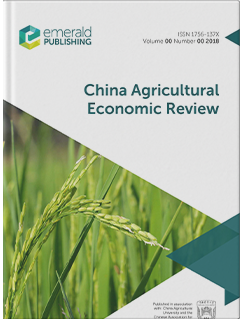农业份额下降与农业产业化——一些程式化的事实与理论解释
IF 4.6
2区 经济学
Q1 AGRICULTURAL ECONOMICS & POLICY
引用次数: 5
摘要
目的农业在产出和就业中所占份额的下降是结构转型的一个核心特征。作者介绍了发达国家和发展中国家在农业份额下降过程中的不同特征,并深入探讨了在农业份额迅速下降期间农业部门发生的真正变化。设计/方法/方法以农业份额下降为线索,作者描绘了发达国家和发展中国家农业份额下降的异质性特征。其次,通过对要素替代假说的批判,认为农业转型的本质是农业生产要素组合、重构和持续变化的农业工业化过程。最后,以农业产业化理论为基础,分析了典型经济体不同阶段农业份额下降的因素组合。研究结果在本文中,作者发现,在发达经济体中,农业就业份额的快速下降伴随着农业生产回报的增加。相比之下,发展中经济体的农业就业份额下降滞后,农业生产效率远低于发达经济体。以美国和日本为例,作者发现农业部门经历了农业工业化,其特征是生产要素组合的重建和升级。原创性/价值作者系统地揭示了发达经济体农业部门在结构转型过程中发生巨大变化的原因,也为发展中国家实现农业现代化提供了进一步的思考和教训。本文章由计算机程序翻译,如有差异,请以英文原文为准。
The decline in agricultural share and agricultural industrialization—some stylized facts and theoretical explanations
PurposeThe decline in the share of agriculture in both output and employment is a central feature of structural transformation. The authors present the distinct features between developed and developing countries in the process of agricultural share decline and dig into the real changes that occurred in the agricultural sector during the rapid decline in the agricultural share.Design/methodology/approachTaking the declining share of agriculture as a clue, the authors depict heterogeneous characteristics in the declining share of agriculture in developed and developing countries. Secondly, by criticizing the factor substitution hypothesis, the authors argue that the essence of agricultural transformation is the process of agricultural industrialization characterized by the combination, reconstruction, and continual changes of agricultural production factors. Finally, based on the theory of agricultural industrialization, this paper analyzes the combination of factors in different stages of declining agricultural share in typical economies.FindingsIn this paper, the authors find that the rapid decline in agricultural employment share is accompanied by an increase in the returns to agricultural production in developed economies. In contrast, the decline in agricultural employment share in developing economies lags, and agricultural production efficiency is way much poorer than that of developed economies. Taking the United States and Japan as examples, the authors find that the agricultural sector underwent agricultural industrialization, featured by reconstruction and upgrades of production factors combination.Originality/valueThe authors systematically reveal why huge changes occurred in the agricultural sector in developed economies during structural transformation, and also provide further thoughts and lessons for developing countries to accomplish agricultural modernization.
求助全文
通过发布文献求助,成功后即可免费获取论文全文。
去求助
来源期刊

China Agricultural Economic Review
AGRICULTURAL ECONOMICS & POLICY-
CiteScore
9.80
自引率
5.90%
发文量
41
审稿时长
>12 weeks
期刊介绍:
Published in association with China Agricultural University and the Chinese Association for Agricultural Economics, China Agricultural Economic Review publishes academic writings by international scholars, and particularly encourages empirical work that can be replicated and extended by others; and research articles that employ econometric and statistical hypothesis testing, optimization and simulation models. The journal aims to publish research which can be applied to China’s agricultural and rural policy-making process, the development of the agricultural economics discipline and to developing countries hoping to learn from China’s agricultural and rural development.
 求助内容:
求助内容: 应助结果提醒方式:
应助结果提醒方式:


